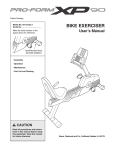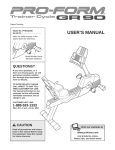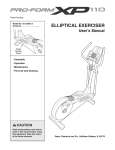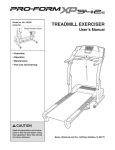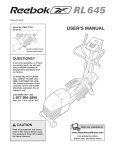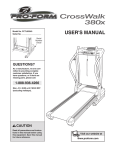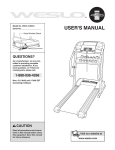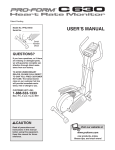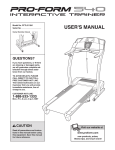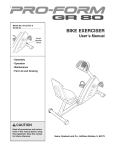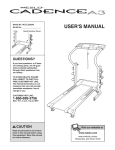Download ProForm 831.215220 Home Gym User Manual
Transcript
Patent Pending Model No. 831.215220 Serial No. Write the serial number in the space above for reference. BIKE EXERCISER User’s Manual Serial Number Decal (beneath stabilizer) • Assembly • Operation • Maintenance • Part List and Drawing CAUTION Read all precautions and instructions in this manual before using this equipment. Keep this manual for future reference. Sears, Roebuck and Co., Hoffman Estates, IL 60179 TABLE OF CONTENTS IMPORTANT PRECAUTIONS . . . . . . . . . . . . . . . . . . . . . . . . . . . . . . . . . . . . . . . . . . . . . . . . . . . . . . . . . . . . . . . .2 BEFORE YOU BEGIN . . . . . . . . . . . . . . . . . . . . . . . . . . . . . . . . . . . . . . . . . . . . . . . . . . . . . . . . . . . . . . . . . . . . . .3 ASSEMBLY . . . . . . . . . . . . . . . . . . . . . . . . . . . . . . . . . . . . . . . . . . . . . . . . . . . . . . . . . . . . . . . . . . . . . . . . . . . . . . .4 HOW TO OPERATE THE EXERCISE CYCLE . . . . . . . . . . . . . . . . . . . . . . . . . . . . . . . . . . . . . . . . . . . . . . . . . . . .8 MAINTENANCE AND TROUBLESHOOTING . . . . . . . . . . . . . . . . . . . . . . . . . . . . . . . . . . . . . . . . . . . . . . . . . . .19 CONDITIONING GUIDELINES . . . . . . . . . . . . . . . . . . . . . . . . . . . . . . . . . . . . . . . . . . . . . . . . . . . . . . . . . . . . . . .20 PART LIST . . . . . . . . . . . . . . . . . . . . . . . . . . . . . . . . . . . . . . . . . . . . . . . . . . . . . . . . . . . . . . . . . . . . . . . . . . . . . .21 EXPLODED DRAWING . . . . . . . . . . . . . . . . . . . . . . . . . . . . . . . . . . . . . . . . . . . . . . . . . . . . . . . . . . . . . . . . . . . .22 HOW TO ORDER REPLACEMENT PARTS . . . . . . . . . . . . . . . . . . . . . . . . . . . . . . . . . . . . . . . . . . . . .Back Cover FULL 90 DAY WARRANTY . . . . . . . . . . . . . . . . . . . . . . . . . . . . . . . . . . . . . . . . . . . . . . . . . . . . . . . . . .Back Cover IMPORTANT PRECAUTIONS WARNING: To reduce the risk of serious injury, read the following important precautions before using the exercise cycle. 9. Wear appropriate clothes when exercising; do not wear loose clothes that could become caught on the exercise cycle. Always wear athletic shoes for foot protection. 1. Read all instructions in this manual before using the exercise cycle. 2. Use the exercise cycle only as described in this manual. 10. The pulse sensor is not a medical device. Various factors, including the user's movement, may affect the accuracy of heart rate readings. The pulse sensor is intended only as an exercise aid in determining heart rate trends in general. 3. It is the responsibility of the owner to ensure that all users of the exercise cycle are adequately informed of all precautions. 4. The exercise cycle is intended for home use only. Do not use the exercise cycle in a commercial, rental, or institutional setting. 11. Always keep your back straight when using the exercise cycle; do not arch your back. 5. Place the exercise cycle indoors on a level surface. Keep the exercise cycle away from moisture and dust. Place a mat under the exercise cycle to protect the floor. 12. If you feel pain or dizziness while exercising, stop immediately and cool down. 13. The exercise cycle does not have a freewheel; the pedals will continue to move until the flywheel stops. 6. Inspect and properly tighten all parts regularly. Replace any worn parts immediately. 14. The decal shown on page 3 has been placed on the exercise cycle. If the decal is missing, or if it is not legible, please call toll-free 1-888-533-1333 and order a free replacement decal. Apply the decal in the location shown. 7. Keep children under the age of 12 and pets away from the exercise cycle at all times. 8. The exercise cycle should not be used by persons weighing more than 250 pounds. WARNING: Before beginning this or any exercise program, consult your physician. This is especially important for persons over the age of 35 or persons with pre-existing health problems. Read all instructions before using. Sears assumes no responsibility for personal injury or property damage sustained by or through the use of this product. 2 BEFORE YOU BEGIN Congratulations for selecting the new PROFORM® XP 90 exercise cycle. Cycling is one of the most effective exercises for increasing cardiovascular fitness, building endurance, and toning the entire body. The PROFORM XP 90 exercise cycle offers an impressive array of features to let you enjoy this healthful exercise in the convenience and privacy of your home. after reading this manual, please call 1-800-4-MYHOME® (1-800-469-4663). To help us assist you, please note the product model number and serial number before calling. The model number is 831.215220. The serial number can be found on a decal attached to the exercise cycle (see the front cover of this manual). For your benefit, read this manual carefully before you use the exercise cycle. If you have questions Before reading further, please familiarize yourself with the parts that are labeled in the drawing below. Book Holder Console Fan Handgrip Pulse Sensor Backrest Wheel Seat Leveling Foot Pedal/Strap Handlebar Seat Lever RIGHT SIDE REAR 3 ASSEMBLY Assembly requires two persons. Place all parts of the exercise cycle in a cleared area and remove the packing materials. Do not dispose of the packing materials until assembly is completed. Assembly requires the included tools and your own adjustable wrench screwdriver . and Phillips Use the drawings below to identify the small parts used for assembly. The number in parenthesis below each drawing is the key number of the part, from the PART LIST on page 21. The number following the key number is the quantity needed for assembly. Note: Some small parts may have been pre-assembled. If a part is not in the parts bag, check to see if it has been pre-assembled. If a part is missing, call toll-free 1-888-533-1333. M6 Washer (66)–4 M8 Split Washer (55)–9 M6 x 16mm Button Screw (8)–4 M8 x 16mm Button Screw (61)–4 M10 Nylon Locknut (72)–4 M8 Nylon Locknut (49)–4 M6 x 20mm Button Screw (63)–3 M4 x 12mm Screw (41)–6 M4 x 20mm Screw (56)–1 M8 x 38mm Button Bolt (58)–4 M8 x 19mm Button Screw (40)–5 M10 x 112mm Carriage Bolt (76)–4 1. Orient the Rear Stabilizer (16) as shown. While another person lifts the Frame Rail (52), attach the Rear Stabilizer to the Leg (20) with two M10 x 112mm Carriage Bolts (76) and two M10 Nylon Locknuts (72). 1 52 76 20 16 72 4 2. Orient the Front Stabilizer (15) as shown. While another person lifts the front of the Frame (1), attach the Front Stabilizer to the Frame with two M10 x 112mm Carriage Bolts (76) and two M10 Nylon Locknuts (72). 2 76 15 1 72 3. Attach the Frame Rail (52) to the Frame (1) with two M8 x 19mm Button Screws (40) and two M8 Split Washers (55). Be careful to avoid damaging the Side Shields (26, 27). 3 27 40 55 52 26 4. While another person holds the Upright (2) in the position shown, connect the Upper Wire Harness (42) to the Lower Wire Harness (43). Gently pull the upper end of the Upper Wire Harness to remove any slack from the Wire Harnesses. Slide the Upright (2) onto the top of the Frame (1) as shown. Attach the Upright with three M8 x 19mm Button Screws (40) and three M8 Split Washers (55). Be careful to avoid pinching the Wire Harnesses (42, 43). 1 4 Make sure the wire harnesses do not get pinched and damaged during this step. 2 42 43 40 55 40 55 40 5 55 1 5. Orient the Seat Carriage Assembly (10) as shown. Attach the Seat Carriage Assembly to the Seat Bracket (11) with four M8 x 16mm Button Screws (61) and four M8 Split Washers (55). 5 61 3 11 Attach a Handlebar (3) to the Seat Bracket (11) with two M8 x 38mm Button Bolts (58) and two M8 Nylon Locknuts (49). Make sure that the Nylon Locknuts are resting in the hexagonal holes in the front of the Handlebar. 55 61 55 49 55 Attach the other Handlebar (3) to the Seat Bracket (11) in the same way. 61 58 3 10 6. Attach the Seat (9) to the Seat Bracket (11) with four M6 x 16mm Button Screws (8) and four M6 Washers (66). 6 9 11 66 66 8 7. Attach the Backrest (31) to the Seat Bracket (11) with three M6 x 20mm Button Screws (63). 8 7 31 11 63 63 6 8. Push down the seat lever (not shown) on the right side of the Seat Carriage Assembly (10), slide the Seat Carriage Assembly into the Frame Rail (52), and then pull the seat lever back up. 8 56 51 Attach a Bumper (51) to the Frame Rail (52) with an M4 x 20mm Screw (56). Next, press the Frame Rail Endcap (50) into the end of the Frame Rail. 52 Seat Lever 10 50 9. The Console (4) requires four 1.5V “D” batteries (not included); alkaline batteries are recommended. Remove the two battery covers from the Console. Next, insert four batteries into the battery compartments. Make sure that the batteries are oriented as shown by the diagrams inside of the battery compartments. Then, reattach the battery covers to the Console. 9 Battery Covers 23 41 Batteries Attach the Book Holder (23) to the Console (4) with two M4 x 12mm Screws (41) as shown. 4 10. While another person holds the Console (4) in the position shown, connect the wire harness on the Console to the Upper Wire Harness (42). Insert the excess wire harness down into the Upright (2). 10 4 41 Attach the Console (4) to the Upright (2) with four M4 x 12mm Screws (41). Be careful to avoid pinching the wire harnesses. 42 41 2 7 Wire Harness 11. Identify the Left Pedal (22), which is marked with an “L.” Using an adjustable wrench, firmly tighten the Left Pedal counterclockwise into the left arm on the Pulley (29). Tighten the Right Pedal (not shown) clockwise into the right arm on the Pulley. Important: Tighten both Pedals as firmly as possible. After using the exercise cycle for one week, retighten the Pedals. For best performance, the Pedals must be kept tightened. 11 25 Adjust the Left Pedal Strap (25) to the desired position, and press the end of the Left Pedal Strap onto the tab on the Left Pedal (22). 29 Tab Adjust the Right Pedal Strap (not shown) in the same way. 22 12. Make sure that all parts are properly tightened before you use the exercise cycle. Note: After assembly is completed, some extra parts may be left over. Place a mat beneath the exercise cycle to protect the floor. HOW TO OPERATE THE EXERCISE CYCLE HOW TO ADJUST THE SEAT HOW TO ADJUST THE PEDAL STRAPS For effective exercise, the seat should be in the proper position. As you pedal, there should be a slight bend in your knees when the pedals are all of the way forward. To adjust Seat Lever the seat, push the seat lever down, slide the seat forward or backward, and then firmly pull the seat lever back up. To adjust the pedal straps, first pull the ends of the straps off the tabs on the pedals. Adjust the straps to the desired position, and then press the ends of the straps back onto the tabs. 8 Pedal Strap Tab CONSOLE DIAGRAM FEATURES OF THE CONSOLE sonal trainer in your home. Using a stereo audio cable (available at electronics stores), you can connect the exercise cycle to your home stereo, portable stereo, computer, or VCR and play special iFIT.com CD and video programs (iFIT.com CDs and videocassettes are available separately). iFIT.com CD and video programs automatically control the resistance of the pedals and prompt you to vary your pace as a personal trainer coaches you through every step of your workout. Highenergy music provides added motivation. To purchase iFIT.com CDs and videocassettes, call toll-free 1-888-533-1333. The advanced console offers a selection of features designed to make your workouts more enjoyable and effective. When the manual mode of the console is selected, the resistance of the pedals can be changed with the touch of a button. As you pedal, the console will provide continuous exercise feedback. You can even measure your heart rate using the built-in handgrip pulse sensor. The console also offers four preset programs. Each program automatically changes the resistance of the pedals and prompts you to increase or decrease your pace as it guides you through an effective workout. With the exercise cycle connected to your computer, you can also go to our Web site at www.iFIT.com and access programs directly from the internet. Explore www.iFIT.com for more information. In addition, the console features two pulse programs that change the resistance of the pedals and prompt you to vary your pace to keep your heart rate near a target heart rate while you exercise. To use the manual mode of the console, see page 10. To use a preset program, see page 12. To use a pulse program, see page 12. To use an iFIT.com CD or video program, see page 17. To use a program directly from our Web site, see page 18. The console also features iFIT.com interactive technology. Having iFIT.com technology is like having a per- 9 The center of the display will show the elapsed time, your pedaling pace in minutes per mile, and the approximate number of grams of carbs you have burned. The display will change from one number to the next every few seconds. Note: When a program is selected (except for the self select program), the display will show the time remaining in the program instead of the elapsed time. HOW TO USE THE MANUAL MODE 1 Turn on the console. To turn on the console, press the On/Reset button On/Reset or begin pedaling. Button Note: If there are sheets of clear plastic on the face of the console, remove the plastic. 2 The lower part of the display will show your pedaling pace in revolutions per minute (RPM), your pedaling speed, and the resistance level of the pedals. The display will change from one number to the next every few seconds. Select the manual mode. When the power is turned on, the manual mode will be selected. If you have selected a program or the iFIT.com mode, reselect the manual mode by pressing the Program button repeatedly until no indicators are lit. 3 To reset the display, press the On/Reset button. Note: The console can show speed and distance in either miles or kilometers. The letters MPH or KM/H will appear in the lower part of the display to show which unit of measurement is selected. To change the unit of measurement, first hold down the Program button for a few seconds. An E (for English) or an M (for metric) will appear in the lower part of the display. Press the Resistance + button to change the unit of measurement. Note: When the batteries are replaced, it may be necessary to reselect the desired unit of measurement. Begin pedaling and change the resistance of the pedals as desired. As you pedal, change the resistance of the pedals by pressing the Resistance buttons. There are ten resistance levels—level 10 is the most challenging. Note: After the buttons are pressed, it will take a moment for the pedals to reach the selected resistance level. 4 Monitor your progress with the display. While you are selecting a unit of measurement, you can also select a backlight mode. The “On” mode keeps the backlight on while the console is on. The “Off” mode turns the backlight off. To conserve the batteries, the “Auto” mode keeps the backlight on only while you are exercising. Press the Resistance – button to change the backlight mode if desired. Then, press the On/Reset button. The upper part of the display will show the distance you have pedaled and the approximate number of calories you have burned. The display will change from one number to the other every few seconds. The upper part of the display will also show your heart rate when you use the handgrip pulse sensor (see step 5 on page 11). 10 5 Measure your heart rate if desired. 6 If there are thin sheets of plastic on the metal contacts on the handgrip pulse sensor, Contacts peel off the plastic. Place your hands on the handgrip pulse sensor, with your palms on the contacts closest to you and your fingers touching the contacts on the opposite side of the handgrip pulse sensor. Avoid moving your hands. When your pulse is detected, the heart-shaped indicator in the upper part of the display will begin to flash each time your heart beats. After a moment your heart rate will be shown. Turn on the fan if desired. To turn on the fan at low speed, press the fan butFan ton. To turn on Button the fan at high speed, press the fan button a second time. To turn off the fan, press Thumb Wheel the fan button a third time. Note: If the fan is turned on but the pedals are not moved for thirty seconds, the fan will automatically turn off. Rotate the thumb wheel on the right side of the fan to adjust the angle of the fan. 7 For the most accurate heart rate reading, continue to hold the handgrips for about 30 seconds. Note: If you continue to hold the handgrip pulse sensor, the display will show your heart rate for up to 30 seconds. The display will then show your heart rate along with the other modes. When you are finished exercising, the console will automatically turn off. If the pedals are not moved for a few seconds, a series of tones will sound, the time will begin to flash, and the console will pause. If the pedals are not moved for a few minutes, the console will turn off and the display will be reset. If your heart rate is not shown, make sure that your hands are positioned as described. Avoid moving your hands excessively or squeezing the metal contacts too tightly. For optimal performance, periodically clean the metal contacts using a soft cloth; never use alcohol, abrasives, or chemicals. 11 indicators on the left side of the pace guide lights, increase your pace; when one of the indicators on the right side lights, decrease your pace. When the center indicator lights, maintain your current pace. Important: The pace guide is intended only to provide a goal. Make sure to pedal at a pace that is comfortable for you. HOW TO USE A PRESET PROGRAM 1 Turn on the console. See step 1 on page 10. 2 Select one of the preset programs. 5 To select a preset program, press the Program button repeatedly until one of the four preset program indicators lights. 3 See step 4 on page 10. 6 Measure your heart rate if desired. See step 5 on page 11. 7 Turn on the fan if desired. See step 6 on page 11. Press the Start button or begin pedaling to start the program. 8 Each preset program consists of several oneminute periods. One resistance setting and one target pace are programmed for each period. Note: The same resistance setting and/or target pace may be programmed for two or more consecutive periods, as shown by the four profiles near the program indicators. When you are finished exercising, the console will automatically turn off. See step 7 on page 11. At the end of each period of the program, a series of tones will sound and the time will flash in the display. The resistance of the pedals will then automatically change if a different resistance setting is programmed for the next period. Note: If the resistance level is too high or too low, you can change it by pressing the Resistance buttons. However, when the current period ends, the resistance of the pedals will automatically change if a different resistance setting is programmed for the next period. HOW TO USE A PULSE PROGRAM Pulse program 1 is designed to keep your heart rate between 65% and 90% of your estimated maximum heart rate during your workout. (Your maximum heart rate is estimated by subtracting your age from 220. For example, if you are 25 years old, your estimated maximum heart rate is 195 beats per minute.) Pulse program 2 is designed to keep your heart rate near a target heart rate that you select. During the program, the center of the display will show the time remaining in the program. If you stop pedaling for several seconds, the program will pause and the time will flash in the display. To restart the program, simply resume pedaling. 4 Monitor your progress with the display. Follow the steps below to use a pulse program. 1 Turn on the console. See step 1 on page 10. Use the pace guide to pace your exercise. Throughout the program, the pace guide above the program indicators will prompt you to increase or decrease your pedaling pace. When one of the 2 Select one of the pulse programs. To select a pulse program, press the Program button repeatedly until one of the two pulse program indicators lights. 12 3 When only three seconds remain in the first period of the program, a series of tones will sound and the time will flash in the display. Enter your age or a target heart rate. If pulse program 1 is selected, the word “AGE” will flash in the lower part of the display. You must enter your age to use this program. If you have already entered your age, press the Enter button and go to step 4. If you have not entered your age, press the + or – button beside the Enter button to enter your age, and then press the Enter button. Note: Once you have entered your age, it will be saved in memory. During the program, the console will regularly compare your heart rate to the target heart rate. If your heart rate is too far below or above the target heart rate, the resistance of the pedals will automatically increase or decrease to being your heart rate closer to the target heart rate. Note: If the resistance level is too high or too low, you can change it by pressing the Resistance buttons. However, when the console compares your heart rate to the target heart rate, the resistance may automatically change. If pulse program 2 is selected, the word “RATE” will flash in the lower part of the display. You must enter a target heart rate to use this program. (See the chart on page 20 for heart rate guidelines.) If you have already entered a target heart rate, press the Enter button and go to step 4. If you have not entered a target heart rate, press the + or – button beside the Enter button, and then press the Enter button. Note: Once you have entered a target heart rate, it will be saved in memory. 4 As you pedal, the pace guide will prompt you to increase or decrease your pedaling pace. When one of the indicators on the left side of the pace guide lights, increase your pace; when one of the indicators on the right side lights, decrease your pace. When the center indicator lights, maintain your current pace. Important: The target heart rate is intended only to provide a goal. Make sure to pedal at a pace that is comfortable for you. Hold the handgrip pulse sensor. It is not necessary to hold the handgrips continuously during a pulse program; however, you must hold the handgrips frequently for the program to operate properly. Each time you hold the handgrips, keep your hands on the metal contacts for at least 30 seconds. Note: When you are not holding the handgrips, the letters PLS will appear in the large display instead of your heart rate. The program will continue until no time remains in the display. If you stop pedaling for several seconds, the program will pause and the time will flash in the display. To restart the program, simply resume pedaling. 6 Follow your progress with the display. See step 4 on page 10. 5 Press the Start button or begin pedaling to start the program. 7 Program 1 consists of 30 one-minute periods. One target heart rate is programmed for each period. (The same target heart rate may be programmed for two or more consecutive periods.) Program 2 is sixty minutes long (you may choose to use only part of the program). The same target heart rate is programmed for the entire program. Turn on the fan if desired. See step 6 on page 11. 8 When you are finished exercising, the console will automatically turn off. See step 7 on page 11. 13 HOW TO CONNECT YOUR PORTABLE STEREO HOW TO CONNECT YOUR CD PLAYER, VCR, OR COMPUTER Note: If your stereo has an RCA-type AUDIO OUT jack, see instruction A below. If your stereo has a 1/8” LINE OUT jack, see instruction B. If your stereo has only a PHONES jack, see instruction C. To use iFIT.com CDs, the exercise cycle must be connected to your portable CD player, portable stereo, home stereo, or computer with CD player. See pages 14 and 15 for connecting instructions. To use iFIT.com videocassettes, the exercise cycle must be connected to your VCR. See page 16 for connecting instructions. To use iFIT.com programs directly from our Web site, the exercise cycle must be connected to your home computer. See page 15 for connecting instructions. A. Plug one end of a 1/8” to RCA stereo audio cable (available at electronics stores) into the jack beneath the console. Plug the other end of the cable into the AUDIO OUT jack on your stereo. A/B AUDIO OUT HOW TO CONNECT YOUR PORTABLE CD PLAYER LINE OUT RIGHT LEFT Note: If your CD player has separate LINE OUT and PHONES jacks, see instruction A below. If your CD player has only one jack, see instruction B. A. Plug one end of a 1/8” to 1/8” stereo audio cable (available at electronics stores) into the jack beneath the console. Plug the other end of the cable into the LINE OUT jack on your CD player. Plug your headphones into the PHONES jack. Audio Cable B. Refer to the drawing above. Plug one end of a 1/8” to 1/8” stereo audio cable (available at electronics stores) into the jack beneath the console. Plug the other end of the cable into the LINE OUT jack on your stereo. A PHONES LINE OUT LINE OUT PHONES C. Plug one end of a 1/8” to 1/8” stereo audio cable (available at electronics stores) into the jack beneath the console. Plug the other end of the cable into a 1/8” Y-adapter (available at electronics stores). Plug the Y-adapter into the PHONES jack on your stereo. Plug your headphones into the other side of the Y-adapter. Headphones Audio Cable B. Plug one end of a 1/8” to 1/8” stereo audio cable (available at electronics stores) into the jack beneath the console. Plug the other end of the cable into a 1/8” Y-adapter (available at electronics stores). Plug the Y-adapter into the PHONES jack on your CD player. Plug your headphones into the other side of the Y-adapter. C PHONES 1/8” Audio Y-adapter Cable B Headphones PHONES PHONES Audio Cable 1/8” Y-adapter Headphones 14 HOW TO CONNECT YOUR HOME STEREO HOW TO CONNECT YOUR COMPUTER Note: If your stereo has an unused LINE OUT jack, see instruction A below. If the LINE OUT jack is being used, see instruction B. Note: If your computer has a 1/8” LINE OUT jack, see instruction A. If your computer has only a PHONES jack, see instruction B. A. Plug one end of a 1/8” to RCA stereo audio cable (available at electronics stores) into the jack beneath the console. Plug the other end of the cable into the LINE OUT jack on your stereo. A. Plug one end of a 1/8” to 1/8” stereo audio cable (available at electronics stores) into the jack beneath the console. Plug the other end of the cable into the LINE OUT jack on your computer. A A CD LINE OUT VCR Amp LINE OUT LINE OUT Audio Cable Audio Cable B. Plug one end of a 1/8” to 1/8” stereo audio cable (available at electronics stores) into the jack beneath the console. Plug the other end of the cable into a 1/8” Y-adapter (available at electronics stores). Plug the Y-adapter into the PHONES jack on your computer. Plug your headphones or speakers into the other side of the Y-adapter. B. Plug one end of a 1/8” to RCA stereo audio cable (available at electronics stores) into the jack beneath the console. Plug the other end of the cable into an RCA Y-adapter (available at electronics stores). Next, remove the wire that is currently plugged into the LINE OUT jack on your stereo and plug the wire into the unused side of the Y-adapter. Plug the Yadapter into the LINE OUT jack on your stereo. B B CD PHONES VCR Amp LINE OUT Audio Cable Audio Cable RCA Y-adapter 1/8” Y-adapter Headphones/Speakers Wire removed from LINE OUT jack 15 B. Plug one end of a 1/8” to RCA stereo audio cable (available at electronics stores) into the jack beneath the console. Plug the other end of the cable into an RCA Y-adapter (available at electronics stores). Next, remove the wire that is currently plugged into the AUDIO OUT jack on your VCR and plug the wire into the unused side of the Yadapter. Plug the Y-adapter into the AUDIO OUT jack on your VCR. HOW TO CONNECT YOUR VCR Note: If your VCR has an unused AUDIO OUT jack, see instruction A below. If the AUDIO OUT jack is being used, see instruction B. If you have a TV with a built-in VCR, see instruction B. If your VCR is connected to your home stereo, see HOW TO CONNECT YOUR HOME STEREO on page 15. A. Plug one end of a 1/8” to RCA stereo audio cable (available at electronics stores) into the jack beneath the console. Plug the other end of the cable into the AUDIO OUT jack on your VCR. B ANT. IN VIDEO AUDIO IN RF OUT CH 3 4 OUT A RCA Y-adapter ANT. IN VIDEO AUDIO IN RF OUT CH 3 4 OUT AUDIO OUT RIGHT LEFT Audio Cable Audio Cable 16 Wire removed from AUDIO OUT jack your workout. Simply follow your personal trainer’s instructions. HOW TO USE AN IFIT.COM CD AND VIDEO PROGRAM The program will function in almost the same way as a preset program (see steps 3 and 4 on page 12). However, an electronic “chirping” sound will alert you when the resistance of the pedals and/or the pace guide is about to change. To use iFIT.com CDs or videocassettes, the exercise cycle must be connected to your portable CD player, portable stereo, home stereo, computer with CD player, or VCR. See HOW TO CONNECT YOUR CD PLAYER, VCR, OR COMPUTER on pages 14 to 16. To purchase iFIT.com CDs and videocassettes, call toll-free 1-833-533-1333. Note: If the resistance of the pedals and/or the pace guide does not change when a “chirp” is heard: Follow the steps below to use an iFIT.com CD or video program. 1 • Make sure that the iFIT.com indicator is lit. • Adjust the volume of your CD player or VCR. If the volume is too high or too low, the console may not detect the program signals. Turn on the console. See step 1 on page 10. 2 • Make sure that the audio cable is properly connected and that it is fully plugged in. Select the iFIT.com mode. 5 To select the iFIT.com mode, press the Program button repeatedly until the iFIT.com indicator lights. 3 See step 4 on page 10. 6 Measure your heart rate if desired. See step 5 on page 11. Insert the iFIT.com CD or videocassette. 7 If you are using an iFIT.com CD, insert the CD into your CD player. If you are using an iFIT.com videocassette, insert the videocassette into your VCR. 4 Monitor your progress with the display. Turn on the fan if desired. See step 6 on page 11. 8 Press the play button on your CD player or VCR. When you are finished exercising, the console will automatically turn off. See step 7 on page 11. A moment after the play button is pressed, your personal trainer will begin guiding you through 17 6 HOW TO USE PROGRAMS DIRECTLY FROM OUR WEB SITE When you start the program, an on-screen countdown will begin. Our Web site at www.iFIT.com allows you to play iFIT.com programs directly from the internet. To use programs from our Web site, the exercise cycle must be connected to your home computer. See HOW TO CONNECT YOUR COMPUTER on page 15. In addition, you must have an internet connection and an internet service provider. A list of specific system requirements is found on our Web site. 7 Turn on the console. 8 See step 1 on page 10. 2 9 To select the iFIT.com mode, press the Program button repeatedly until the iFIT.com indicator lights. Go to your computer and start an internet connection. 4 Start your Web browser, if necessary, and go to our Web site at www.iFIT.com. 5 Follow the desired links on our Web site to select a program. Monitor your progress with the display. See step 4 on page 10. Select the iFIT.com mode. 3 Return to the exercise cycle and begin pedaling. When the on-screen countdown ends, the program will begin. The program will function in almost the same way as a preset program (see steps 3 and 4 on page 12). However, an electronic “chirping” sound will alert you when the resistance of the pedals and/or the pace guide is about to change. Follow the steps below to use a program from our Web site. 1 Follow the on-line instructions to start the program. Measure your heart rate if desired. See step 5 on page 11. 10 Turn on the fan if desired. See step 6 on page 11. 11 When you are finished exercising, the console will automatically turn off. See step 7 on page 11. Read and follow the on-line instructions for using a program. 18 MAINTENANCE AND TROUBLESHOOTING Inspect and tighten all parts of the exercise cycle regularly. Replace any worn parts immediately. HOW TO LEVEL THE EXERCISE CYCLE After the exercise cycle has been moved to the location where it will be used, make sure that both ends of front stabilizer are Leveling touching the floor. Foot If the exercise cycle rocks slightly during use, turn one or both of the leveling feet under the front stabilizer until the rocking motion is eliminated. To clean the exercise cycle, use a damp cloth and a small amount of mild soap. Important: To avoid damage to the console, keep liquids away from the console and keep the console out of direct sunlight. HOW TO MOVE THE EXERCISE CYCLE To move the exercise cycle, stand behind it and lift the frame in the location shown below. To reduce the risk of injury, bend your legs and keep your back straight. As you lift the frame, make sure to lift with your legs rather than your back. Carefully move the exercise cycle on the front wheels, and then lower the frame. HANDGRIP PULSE SENSOR TROUBLESHOOTING • Avoid moving your hands while using the handgrip pulse sensor. Excessive movement may interfere with heart rate readings. • Do not hold the metal contacts too tightly; doing so may interfere with heart rate readings. Wheel • For the most accurate heart rate reading, hold the metal contacts for about 30 seconds. Lift Here • For optimal performance of the handgrip pulse sensor, keep the metal contacts clean. The contacts can be cleaned with a soft cloth; never use alcohol, abrasives, or chemicals. BATTERY REPLACEMENT If the displays on the console become dim, the batteries should be replaced. Most console problems are the result of low batteries. See assembly step 9 on page 7 for battery replacement instructions. 19 CONDITIONING GUIDELINES The following guidelines will help you to plan your exercise program. Remember that proper nutrition and adequate rest are essential for successful results. During the first few minutes of exercise, your body uses easily accessible carbohydrate calories for energy. Only after the first few minutes of exercise does your body begin to use stored fat calories for energy. If your goal is to burn fat, adjust the intensity of your exercise until your heart rate is near the lowest number in your training zone as you exercise. For maximum fat burning, adjust the intensity of your exercise until your heart rate is near the middle number in your training zone as you exercise. WARNING: Before beginning this or any exercise program, consult your physician. This is especially important for persons over the age of 35 or persons with pre-existing health problems. Aerobic Exercise The pulse sensor is not a medical device. Various factors may affect the accuracy of heart rate readings. The pulse sensor is intended only as an exercise aid in determining heart rate trends in general. If your goal is to strengthen your cardiovascular system, your exercise must be “aerobic.” Aerobic exercise is activity that requires large amounts of oxygen for prolonged periods of time. This increases the demand on the heart to pump blood to the muscles, and on the lungs to oxygenate the blood. For aerobic exercise, adjust the intensity of your exercise until your heart rate is near the highest number in your training zone. EXERCISE INTENSITY Whether your goal is to burn fat or to strengthen your cardiovascular system, the key to achieving the desired results is to exercise with the proper intensity. The proper intensity level can be found by using your heart rate as a guide. The chart below shows recommended heart rates for fat burning, maximum fat burning, and cardiovascular (aerobic) exercise. WORKOUT GUIDELINES Each workout should include the following three parts: A warm-up, consisting of 5 to 10 minutes of stretching and light exercise. A proper warm-up increases your body temperature, heart rate, and circulation in preparation for exercise. Training zone exercise, consisting of 20 to 30 minutes of exercising with your heart rate in your training zone. Note: During the first few weeks of your exercise program, do not keep your heart rate in your training zone for longer than 20 minutes. A cool-down, with 5 to 10 minutes of stretching. This will increase the flexibility of your muscles and will help to prevent post-exercise problems. To find the proper heart rate for you, first find your age at the bottom of the chart (ages are rounded off to the nearest ten years). Next, find the three numbers above your age. The three numbers are your “training zone.” The lowest number is the recommended heart rate for fat burning; the middle number is the recommended heart rate for maximum fat burning; the highest number is the recommended heart rate for aerobic exercise. EXERCISE FREQUENCY To maintain or improve your condition, plan three workouts each week, with at least one day of rest between workouts. After a few months of regular exercise, you may complete up to five workouts each week, if desired. Remember, the key to success is make exercise a regular and enjoyable part of your everyday life. Fat Burning To burn fat effectively, you must exercise at a relatively low intensity level for a sustained period of time. 20 PART LIST—Model No. 831.215220 Key No. Qty. 1 2 3 4 5 6 7 8 9 10 11 12 13 14 15 16 17 18 19 20 21 22 23 24 25 26 27 28 29 30 31 32 33 34 35 36 37 38 39 40 1 1 2 1 1 1 2 6 1 1 1 1 1 2 1 1 2 1 2 1 1 1 1 2 1 1 1 2 1 1 1 2 1 1 1 1 1 1 1 9 Description R1104A Key No. Qty. Frame Upright Handlebar Console “C” Magnet Bracket Flywheel Axle M6 Nut M6 x 16mm Button Screw Seat Seat Carriage Assembly Seat Bracket Left Front Endcap Right Front Endcap Rear Stabilizer Endcap Front Stabilizer Rear Stabilizer Wheel Right Pedal Strap Leveling Foot Leg Right Pedal Left Pedal Book Holder Handlebar Endcap Left Pedal Strap Left Side Shield Right Side Shield Foam Grip Pulley Magnet Backrest Flywheel Washer Crank Bearing Set Flywheel “C” Magnet Resistance Cable Assembly Spring Resistance Motor Right Rail Cover M8 x 19mm Button Screw 41 42 43 44 45 46 47 48 49 50 51 52 53 54 55 56 57 58 59 60 61 62 63 64 65 66 67 68 69 70 71 72 73 74 75 76 77 78 # # 8 1 1 1 1 1 1 1 6 1 2 1 1 1 13 2 10 4 4 4 4 6 3 8 8 5 7 4 2 2 4 4 1 4 2 4 1 2 1 1 Description M4 x 12mm Screw Upper Wire Harness Lower Wire Harness Left Rail Cover Clamp Reed Switch/Wire Drive Belt Flywheel Cover M8 Nylon Locknut Frame Rail Endcap Bumper Frame Rail Right Belt Cover Left Belt Cover M8 Split Washer M4 x 20mm Screw M4 x 16mm Screw M8 x 38mm Button Bolt M4 Washer M4 x 25mm Screw M8 x 16mm Button Screw M4 x 10mm Screw M6 x 20mm Button Screw Small Snap Ring Carriage Wheel M6 Washer M4 x 38mm Screw M4 x 15mm Flange Bolt Eyebolt Flywheel Bearing M4 Nylon Locknut M10 Nylon Locknut Flywheel Bracket M6 Nylon Locknut M6 x72mm Button Screw M10 x 112mm Carriage Bolt Stop Bolt Seat Carriage Endcap Allen Wrench User’s Manual Note: “#” indicates a non-illustrated part. Specifications are subject to change without notice. If a part is missing, call toll-free 1-888-533-1333. See the back cover of this manual for information about ordering replacement parts. 21 EXPLODED DRAWING—Model No. 831.215220 R1104A 24 28 9 31 3 49 63 55 58 61 55 24 63 11 55 49 28 3 61 55 66 66 65 58 64 8 10 27 65 8 78 64 65 78 64 65 65 64 64 57 53 57 60 60 48 54 57 62 57 67 62 57 60 67 44 60 67 26 67 57 22 39 49 74 69 6 73 34 66 74 8 41 37 69 49 23 70 32 35 32 70 74 8 5 41 4 77 7 41 17 2 75 17 75 25 40 41 45 40 55 46 18 55 22 21 13 29 15 30 76 19 40 33 1 55 56 51 12 19 72 41 71 59 56 52 71 51 59 36 50 38 42 68 55 43 20 14 16 76 40 47 14 72 23 FULL 90 DAY WARRANTY For 90 days from the date of purchase, if failure occurs due to defect in material or workmanship in this Sears Bike Exerciser, contact the nearest Sears Service Center throughout the United States and Sears will repair or replace the Bike Exerciser, free of charge. This warranty does not apply when the Bike Exerciser is used commercially or for rental purposes. This warranty gives you specific legal rights, and you may also have other rights which vary from state to state. Sears, Roebuck and Co., Dept. 817WA, Hoffman Estates, IL 60179 Part No. 219362 R1104A Printed in China © 2004 Sears, Roebuck and Co.
























